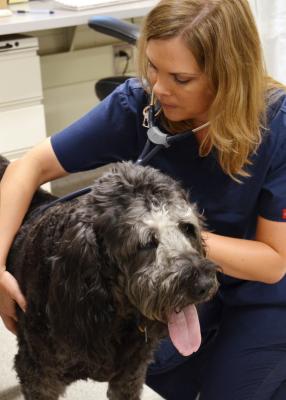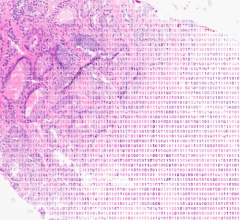
August 8, 2014 — When Michael and Sandra Friedlander first came to the Virginia-Maryland College of Veterinary Medicine three years ago with their dog, Grayton, they learned some bad news: Grayton had nasal adenocarcinoma, a form of cancer with a short life expectancy.
“Most dogs with this form of cancer are with their owners no more than a few months after the diagnosis, but here Grayton is three years later,” said Michael Friedlander, who is the executive director of the Virginia Tech Carilion Research Institute and senior dean at the Virginia Tech Carilion School of Medicine.
No stranger to medical research, Friedlander was referred by Veterinary Teaching Hospital clinicians to an experimental treatment at the University of Florida called stereotactic radiation therapy, which delivers precise, high dosages of radiation to a tumor and can only be performed once.
“That shrunk the tumor down to almost nothing,” said Friedlander, who is also the associate provost for health sciences at Virginia Tech. “We knew when Grayton had the procedure that we couldn’t do it again, but now the cancer is back.”
Today, the 11-year-old Labradoodle is the first patient at the Virginia-Maryland College of Veterinary Medicine in a new clinical trial that is testing the use of gold nanoparticles and a targeted laser treatment for solid tumors in dogs and cats. The study is one of several on new treatments for client-owned companion animals at the college. In January, the college established the Veterinary Clinical Research Office to help facilitate this work.
“Clinical research at the veterinary college involves both primary research focused on advancing the treatment and diagnosis of veterinary diseases and translational research in which spontaneous diseases in animals can be used as models of human disease,” said Greg Daniel, head of the Department of Small Animal Clinical Sciences. “In the latter situation, we can provide our companion animal patients with treatment and diagnostic options that are not yet available in mainstream human medicine.”
Although medical researchers have tested gold nanoparticles with targeted laser treatments on human patients with some success, the treatment is still new to both human and veterinary medicine. The college is one of four current veterinary schools around the country testing the AuroLase therapy developed by Nanospectra Biosciences Inc., a startup company based in Houston, Texas. The others are Texas A&M University, the University of Wisconsin-Madison, and the University of Georgia.
Nick Dervisis, assistant professor of oncology in the Department of Small Animal Clinical Sciences, is leading the Nanospectra-funded study. Following a rhinoscopy performed on Grayton by David Grant, associate professor of internal medicine, Dervisis began the one-time, experimental therapy.
“The treatment involves two phases,” Dervisis said. “First, we infuse the patient with the gold nanoparticles. Although the nanoparticles distribute throughout the body, they tend to concentrate around blood vessels associated with tumors. Within 36 hours, they have cleared the bloodstream except for tumors. The gold nanoparticles are small enough to circulate freely in the bloodstream and become temporarily captured within the incomplete blood vessel walls common in solid tumors. Then, we use a non-ablative laser on the patient.”
Dervisis explained that a non-ablative laser is not strong enough to harm the skin or normal tissue, but “it does cause the remaining nanoparticles to absorb the laser energy and convert it into heat so that they damage the tumor cells.”
Like all clinical trials, the study involves many unknowns, including the treatment’s usefulness and effectiveness. One month after the AuroLase treatment, the nosebleeds that initially brought Grayton back to the Veterinary Teaching Hospital had stopped and Grayton has no other side effects.
“I’m delighted with the care and service that Grayton has received at the veterinary college,” said Friedlander, who explained that the treatment appears to be safe even though researchers do not know whether it is effective yet. “Grayton recently came with us on our annual vacation at the beach. We didn’t know if he would be able to come again, so it was great to have him with us swimming, catching fish and crabs, and doing what dogs do.”
Current clinical trials at the veterinary college range from the use of magnetic resonance imaging (MRI) to distinguish between benign and cancerous lymph nodes in dogs with oral melanoma, to a new chemotherapy drug for dogs with brain tumors, to the treatment of invasive skin cancer in horses with high-voltage, high-frequency electrical pulses.
Mindy Quigley, who oversees the college’s Veterinary Clinical Research Office, explained that veterinary trials, which follow a four-phase process and a variety of regulations similar to human medicine, have another layer of complexity that human trials do not.
“Variation among species means that a therapy that has proven safe and effective in, for example, humans or dogs, may not work for horses,” said Quigley, who comes to the college from the University of Edinburgh’s College of Medicine and Veterinary Medicine, where she helped set up a new neurology research clinic with funding from author J.K. Rowling. “Many veterinary clinical trials must therefore take therapies that have worked in one species and test them in other species with similar conditions. This is a necessary step to determine if a proposed treatment is safe and effective for our companion animals.”
Grayton may be the first companion animal in theAuroLase study at the veterinary college, but he certainly won’t be the last. Dervisis is continuing to enroll patients in the study and is seeking dogs and cats of a certain size with solid tumors who have not recently received radiation therapy or chemotherapy.
For more information: www.vtnews.vt.edu/articles/2014/08/080414-vetmed-clinicaltrials.html


 November 11, 2025
November 11, 2025 








